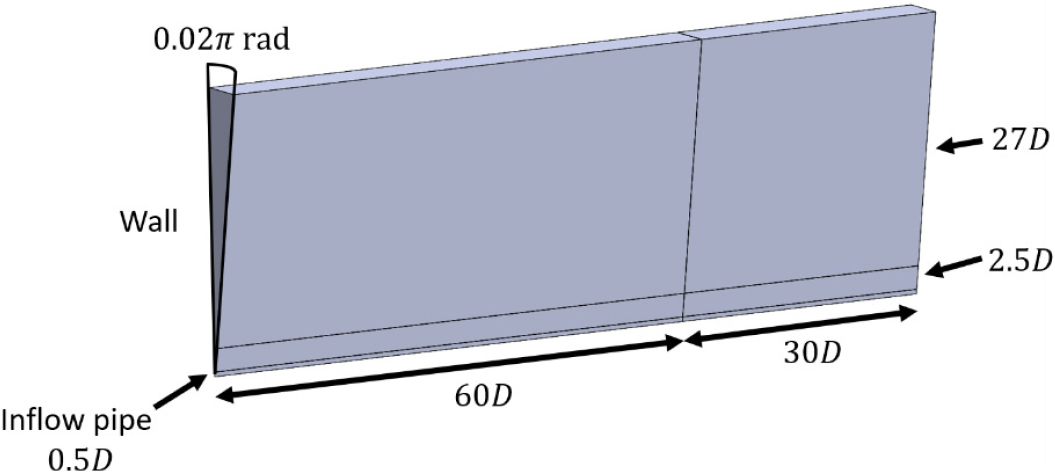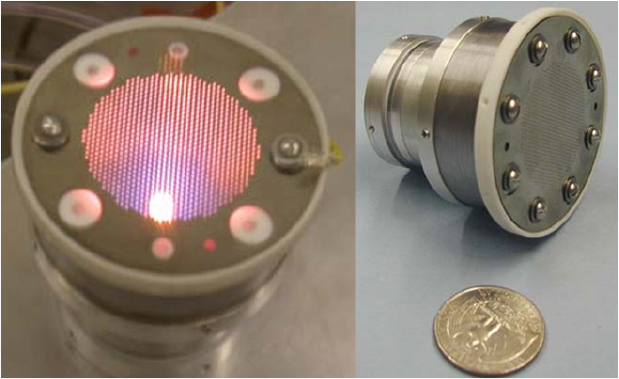-
Research Article
- Optimization of RANS Coefficients for Steady and Decelerating Turbulent Jets
- Youngik Song, Vlad Aparece-Scutariu, Dong-hyuk Shin
- The RANS model is optimized for steady and decelerating axisymmetric turbulent jets. The k - ε model was found to be the …
- The RANS model is optimized for steady and decelerating axisymmetric turbulent jets. The k - ε model was found to be the most suitable candidate for optimization, and two optimized coefficient sets were developed as a result. Each set minimizes the sum of root mean square errors, with one set focused on mean velocities and the other on both mean velocities and Reynolds shear stress. The self-similarity of standard and optimized RANS coefficient sets was then investigated. The optimized sets demonstrated improved self-similarity over the standard coefficient set, showing a close match with a C a value of 2.2. - COLLAPSE

-
Research Article
- Numerical Studies on the Flame Structures and Combustion Performance of Supersonic Turbulent Combustion in DCR
- Bu-Kyeng Sung, Min-Seon Jo, Jae-Eun Kim, Jeong-Yeol Choi
- A numerical study was carried out to investigate the flame structures and combustion performance of supersonic turbulent combustion in a dual combustion …
- A numerical study was carried out to investigate the flame structures and combustion performance of supersonic turbulent combustion in a dual combustion ramjet (DCR) engine. A multi-dimensional fifth-order high-resolution scheme was used to capture the fine-scale turbulence eddy dynamics. Two series of numerical experiments were carried out for the DCR combustors: one with various divergence angles and the other with different lengths of the constant-area combustor section. The operating conditions were selected by considering the flight conditions. The turbulent flame structure and combustion performance were analyzed according to the scalar dissipation rate and other flow parameters. Two different combustion modes were found according to the formation of Mach reflection, which reduces the scalar dissipation rate. The dynamic characteristics of combustion were investigated by the variation of wall pressure and other properties. The critical conditions for combustion stabilization were determined from the coupling of pressure waves interacting with turbulent combustion. The results show that the shock compression and turbulent combustion support each other, similarly to detonation phenomena. - COLLAPSE

-
Research Article
- Effects of Inlet and Outlet Layout on the Outflow Uniformity of Dividing Manifolds
- Bin Li, Tae Seon Park
- The flow control capability of a manifold system is useful in various heat transfer applications. Based on the dividing and bifurcation types …
- The flow control capability of a manifold system is useful in various heat transfer applications. Based on the dividing and bifurcation types of conventional heat exchangers, two types of anti-parallel and parallel of inlet and outlet are proposed. To explore the best manifold, the effects of the inlet Reynolds number, the number of outlet branches, and the inlet position are numerically investigated for the flow maldistribution. For all manifold types, the equilibrium state of friction and momentum forces is observed and the outflow non-uniformity is mostly intensified by the increased number of outlet branches. However, the non-uniformity of the proposed two manifolds is improved with increasing Reynolds number. Also, it is observed that the even number of outlet branches is proper to the bifurcation type manifold. For anti-parallel type manifold of inlet and outlet, the maximum non-uniformity is improved by more than 70% due to the inlet position movement. - COLLAPSE

-
Research Article
- Experimental Study for Development of Thermal Cracking Reaction Model of exo-THDCPD under Supercritical Condition
- Seung Mook Park, Seung Hyeon Lee, Jun Su Kang, Hyung Ju Lee, Hojin Choi, Dong-Chang Park
- Active regeneration cooling is one of the key technologies used to solve the high-temperature heating issues of hypersonic vehicles by utilizing hydrocarbon …
- Active regeneration cooling is one of the key technologies used to solve the high-temperature heating issues of hypersonic vehicles by utilizing hydrocarbon aviation fuel as a coolant. In the regenerative cooling system, the fuel flows through the cooling channels and is heated to a supercritical state, absorbing a large amount of heat and undergoing endothermic decomposition. The fuel decomposed in this way significantly impacts both the cooling characteristics of the hypersonic vehicle and the combustion performance of the scramjet engine. Therefore, in this study, a batch reactor experimental device was used to investigate the pyrolysis characteristics of exo-THDCPD (C10H16, exo-tetrahydrodicyclopentadiene), the main component of high-density hydrocarbon jet fuel JP-10. Specifically, experiments were conducted to induce pyrolysis under conditions where the fuel is maintained in a supercritical state, with an initial pressure at 4 MPa, temperatures ranging from 550-630°C, and reaction times between 50 and 280 seconds. Under these reaction conditions, the maximum fuel conversion rate and gas production rate were found to be approximately 77% and 48%, respectively. Analysis of the pyrolysis products using GC-MS, GC-FID, and GC-TCD systems revealed that the main gaseous products were hydrogen, methane, ethylene, ethane, propylene, and propane. Meanwhile, liquid products were detected in quantities ranging from several dozen to over a hundred species, depending on the fuel conversion rate, and these were classified and analyzed based on their parent molecular structure. Based on these experimental data, a global one-step reaction PPD (Proportional Product Distribution) model for exo-THDCPD was developed, and computational fluid dynamics (CFD) simulations were performed to verify the model. The results from the numerical analysis under various heat flux conditions, represented by the fuel temperature and conversion rate at the microchannel exit, were found to match very well with existing experimental data obtained from the authors’ research group as well as with data from the open literature. The PPD model for exo-THDCPD developed in this study is expected to be useful for the design and analysis of regenerative cooling systems for hypersonic cruise vehicles. - COLLAPSE

-
Research Article
- Shock Wave-assisted One-pot Synthesis of Ternary Heterojuction Nanocomposites
- Kiwon Kim, P. Sivaprakash, S. A. Martin Britto Dhas, P. Velusamy, Ikhyun Kim
- Shock wave research in solid state science is an emerging technology, and researchers are investigating to understand the material’s properties for a …
- Shock wave research in solid state science is an emerging technology, and researchers are investigating to understand the material’s properties for a broad range of advanced applications. In this work, we synthesized a ternary composite of g-C3N4/WS2/Mo3S4 using one-pot synthesis techniques. X-ray diffraction reveals that the g-C3N4/WS2/Mo3S4 composite exhibits a mixed ternary phase, and there are no changes in the spectrum for 100, 200, and 300 shock waves. Additionally, the composite morphology demonstrates a sheet-shaped structure for both the control and shocked samples. However, the sheet-like structure becomes fragmented at higher shock levels due to the shock compression. The XPS spectrum confirms the presence of the expected elements in the composite, and there are no significant changes under shock conditions, which aligns with the X-ray diffraction results. - COLLAPSE

-
Research Article
- Conceptual Design of RF Ion thruster for Microsatellites
- Jeongho Kim, Jiwoong Jung, Junwoo Jung, Kyungmi Park, Woojin Joung, Sanghoo Park, Dong-Hyun Cho, Holak Kim
- With the increasing demand for microsatellites, research on low-power electric thrusters suitable for satellites has been actively conducted. In this study, a …
- With the increasing demand for microsatellites, research on low-power electric thrusters suitable for satellites has been actively conducted. In this study, a conceptual design of an RF ion thruster for microsatellites was performed. The mission orbit for a 6U CubeSat was defined, and the propulsion system requirements were analyzed to utilize argon as the propellant and to operate with 20 W of RF power, ensuring a thrust of approximately 0.3 mN and a specific impulse of 1500 s. A detailed conceptual design of the RF ion thruster, including the grid system and plasma generation chamber, was conducted under the given constraints. Consequently, the thruster was designed to generate a thrust of 0.3 mN and a specific impulse of 1530 s at an argon flow rate of 0.35 sccm. - COLLAPSE

-
Research Article
- N2O Decomposition on Ru/Si-doped Alumina Catalyst for Monopropellant Thruster
- Myoungjin Kim, Taegyu Kim
- In the present study, ruthenium (Ru) catalysts supported on silicon-doped alumina (Si-Al2O3) were prepared and catalytic decomposition of …
- In the present study, ruthenium (Ru) catalysts supported on silicon-doped alumina (Si-Al2O3) were prepared and catalytic decomposition of nitrous oxide (N2O) on the Ru/Si-Al2O3 catalyst at high temperatures were investigated. The Si-Al2O3 was heat-treated at a high temperature of 1200°C. The effect of Si addition on Al2O3 surface structure was investigated using SEM/EDS and XRD analysis. The N2O decomposition on the prepared catalysts was evaluated as the reaction temperature increased. It was shown that Si addition prevented the γ-Al2O3 phase transforming to α-Al2O3. The Ru/Si-Al2O3 catalyst showed a superior reactivity for the N2O decomposition. A subscale N2O monopropellant thruster containing the Ru/Si-Al2O3 catalyst chamber was manufactured. The temperature of 300°C was required to start N2O decomposition. The chamber temperature increased to 1063°C at N2O mass flow rate of 1.93 g/s. The chamber pressure was 5 bar at 1063°C; thus, the c*-efficiency was calculated as 89.05%. - COLLAPSE

Journal Informaiton
 Journal of Propulsion and Energy
Journal of Propulsion and Energy
Journal Informaiton
Journal Informaiton - close
 Journal of Propulsion and Energy
Journal of Propulsion and Energy










